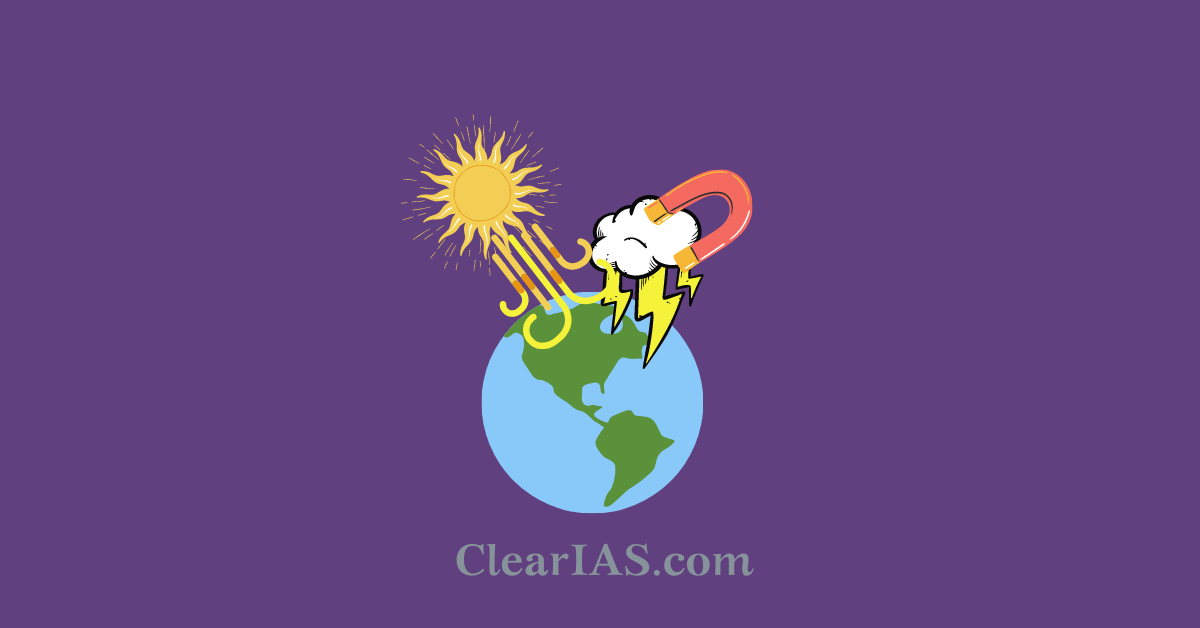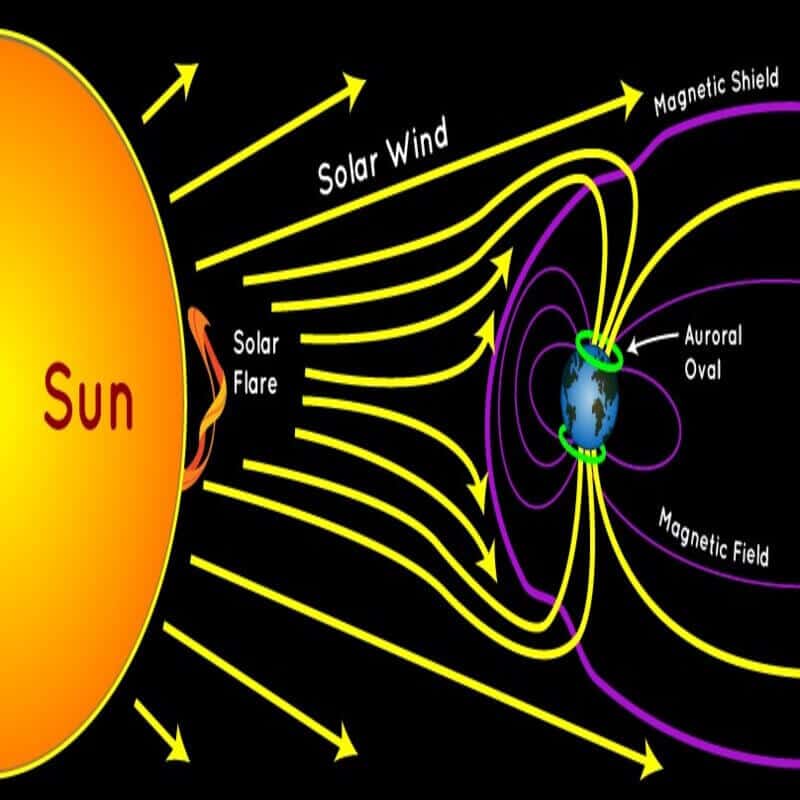
Geomagnetic storms are frequently in the news and are an interesting phenomenon to study. Read here to know more.
Geomagnetic storms underscore the interconnectedness of solar activity and Earth’s environment, with effects spanning from breathtaking natural phenomena to serious technological risks.
The most visible effect of geomagnetic storms is the appearance of auroras (northern and southern lights), caused by solar particles colliding with molecules in Earth’s atmosphere.
What is a geomagnetic storm?
A geomagnetic storm is a major disturbance of Earth’s magnetosphere that occurs when there is an exchange of energy from the solar wind into the space environment surrounding Earth.
Solar storms are caused by the release of magnetic energy called solar winds from the sunspots.
These storms result from variations in the solar wind that cause major changes in the currents, plasmas, and fields in Earth’s magnetosphere.
Solar Storms happen when Sun emits large bursts of energy in the form of solar flares and coronal mass ejections. These phenomena send a stream of electrical charges and magnetic fields toward the Earth at high speed.
Solar Storms are of the following types:
- Solar Flares: A solar flare is a sudden flash of increased brightness on the Sun, usually observed near its surface and in proximity to a sunspot group.
- Coronal Mass Ejection: A coronal mass ejection (CME) is a significant release of plasma and accompanying magnetic field from the solar corona. They often follow solar flares and are normally present during a solar prominence eruption.
- Geomagnetic Storm: A geomagnetic storm is a temporary disturbance of the Earth’s magnetosphere caused by a solar wind shock that interacts with the Earth’s magnetic field.
- Solar Particle Events: A solar particle event or solar proton event (SPE), or prompt proton event, occurs when particles (mostly protons) emitted by the Sun become accelerated either close to the Sun during a flare or in interplanetary space by coronal mass ejection shocks.
The solar wind conditions that are required for creating geomagnetic storms are:
- Many hours of the high-speed solar wind,
- A southward directed solar wind magnetic field (opposite to the direction of Earth’s field) at the dayside of the magnetosphere
These conditions are effective for transferring energy from the solar wind into Earth’s magnetosphere.
The largest storms that result from these conditions are associated with solar coronal mass ejections (CMEs) where a billion tons or so of plasma from the sun, with its embedded magnetic field, arrives at Earth. CMEs typically take several days to arrive on Earth but have been observed, for some of the most intense storms, to arrive in as short as 18 hours.
Other important terms to know:
Sunspots: The dark regions on the Sun are cooler than the surrounding photosphere which is also the lowest layer of the solar atmosphere.
Solar wind: The solar wind is created by the outward expansion of plasma (a collection of charged particles) from the Sun’s corona (outermost atmosphere). This plasma is continually heated to the point that the Sun’s gravity can’t hold it down. It then travels along the Sun’s magnetic field lines that extend radially outward.
Magnetosphere: A magnetosphere is a region around a planet dominated by the planet’s magnetic field. Other planets in our solar system have magnetospheres, but Earth has the strongest one of all the rocky planets: Earth’s magnetosphere is a vast, comet-shaped bubble, which has played a crucial role in our planet’s habitability. It protects the planet from harmful solar and cosmic radiation as well.
Effect of a geomagnetic storm on Earth
Following are the major and minor impacts observed during the solar storms on Earth:
Space weather:
The space weather in the near-earth region and upper atmosphere is hugely impacted even if the solar storm does not reach the Earth.
Space dependent operations:
Solar storms affect space-dependent services like the Global Positioning Systems (GPS), satellite communications, and radio communications, so on. Operations like flight paths, space exploration programs, and power grids are also vulnerable to impact.
- During storms, the currents in the ionosphere, as well as the energetic particles that precipitate into the ionosphere add energy in the form of heat that can increase the density and distribution of density in the upper atmosphere, causing extra drag on satellites in low-earth orbit.
- The local heating also creates strong horizontal variations in the ionospheric density that can modify the path of radio signals and create errors in the positioning information provided by GPS.
- While the storms create beautiful aurora, they also can disrupt navigation systems such as the Global Navigation Satellite System (GNSS) and create harmful geomagnetic induced currents (GICs) in the power grid and pipelines.
- Astronauts on spacewalks face health risks from possible exposure to solar radiation outside the Earth’s protective atmosphere.
What are Auroras?

An aurora is a colorful light show in the sky caused by the Sun’s flares.
Auroras occur when particles from the Sun interact with gases of the Earth’s atmosphere, causing beautiful displays of light in the sky.
Auroras are often seen in areas near the North Pole and the South Pole. It is called aurora borealis or northern lights on the North Pole and aurora australis or southern lights on the South Pole.
Auroras are a special treat because of the beautiful light show in the sky.
When a solar storm comes toward the Earth, some of the energy and small particles can travel down the magnetic field lines at the north and south poles into Earth’s atmosphere.
Any planet in the solar system that has an atmosphere and magnetic field, has auroras. Planets like Jupiter and Saturn have beautiful auroras.
How are geomagnetic storms predicted?
Solar Storms or geomagnetic storms are predicted by:
- Solar physicists and other scientists deploy computer models to forecast solar storms and other solar activity.
- Current models can forecast the arrival timing and pace of a storm. But the structure or orientation of the storm cannot be foreseen.
The magnetic field orientations can cause a more intense response in the magnetosphere which results in more violent magnetic storms.
Since the dependence of the world is increasing on satellites for most activities, it is imperative that space weather forecasts are improved and more efficient measures to safeguard satellites are invented.
News about geomagnetic storm
Geomagnetic storm set to hit earth after filament eruption from the sun.
- The geomagnetic storm heading towards the Earth will be a minor one, according to NOAA. It was generated by solar activity on March 3.
Frequently Asked Questions (FAQs)
Q. How do geomagnetic storms affect humans?
Ans: The Earth’s magnetic field does not directly affect human health. Humans evolved to live on this planet. High-altitude pilots and astronauts can experience higher levels of radiation during magnetic storms, but the hazard is due to the radiation, not the magnetic field itself.
Q. What is the largest solar storm ever recorded?
Ans: The Carrington Event: In 1859, British astronomer Richard Carrington saw a blast of white light on the surface of the sun. This was the Carrington Event, as scientists now call it, and it is the largest recorded solar storm ever recorded.






Leave a Reply